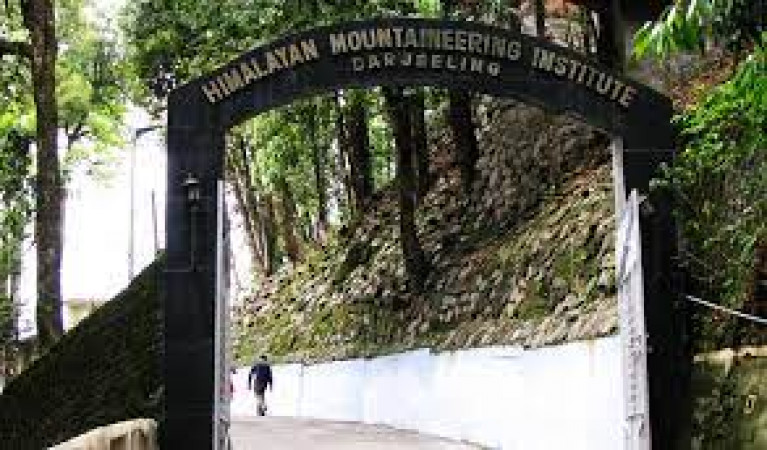
Himalayan Mountaineering Institute
Duration
1 to 2 Days
1 to 2 Days
Best time to visit
Mar-May, Oct-Nov
Mar-May, Oct-Nov
Theme
Adventure, Hill Station
Adventure, Hill Station
Himalayan Mountaineering Institute Travel Guide
The Himalayan Mountaineering Institute, located in Darjeeling, India, is a renowned mountaineering institute established in 1954 by Tenzing Norgay, one of the first two individuals known to have reached the summit of Mount Everest. The institute offers various courses on mountaineering and adventure sports, attracting enthusiasts and adventurers from around the world. Darjeeling, known for its picturesque tea gardens and stunning views of the Himalayas, is a popular destination for nature lovers and adventure seekers.Top Attractions in Himalayan Mountaineering Institute
- Observatory Hill
- Tiger Hill
- Batasia Loop
- Ghoom Monastery
- Darjeeling Himalayan Railway
Himalayan Mountaineering Institute is Famous for
Adventure enthusiasts and mountaineers flock to the Himalayan Mountaineering Institute to learn from the best and explore the breathtaking Himalayan ranges.Top Attractions in Himalayan Mountaineering Institute
- Explore the Darjeeling Himalayan Railway, a UNESCO World Heritage Site
- Witness the sunrise at Tiger Hill with panoramic views of Mount Everest and Mount Kanchenjunga
- Visit the Himalayan Zoological Park to see the endangered species like the Red Panda
- Experience the vibrant local culture at the Tibetan Refugee Self Help Centre
- Shop for traditional handicrafts and teas at the local markets
What's Great about Travelling to Himalayan Mountaineering Institute?
- Perfect destination for adventure seekers and nature lovers
- Opportunity to learn mountaineering from experts at the renowned institute
- Breathtaking views of the Himalayan ranges
What's Not So Great about Travelling to Himalayan Mountaineering Institute?
- High altitude may not be suitable for individuals with health issues
- Limited accessibility to certain remote areas
- Weather can be unpredictable in the Himalayan region
Travel Tips for Himalayan Mountaineering Institute
- Obtain necessary permits for trekking and mountaineering in advance
- Pack appropriate clothing and gear for varying weather conditions
- Acclimatize properly to the high altitude to avoid altitude sickness
Important Himalayan Mountaineering Institute trip information
- Ideal Duration: A week to explore the institute and surrounding attractions
- Best Time to Visit: March to May and October to December for pleasant weather
- Nearby Airports and Railway Stations: Bagdogra Airport and New Jalpaiguri Railway Station
FAQ's on Himalayan Mountaineering Institute
Q1: What is the best time to visit Himalayan Mountaineering Institute?
The best time to visit the Himalayan Mountaineering Institute is during the spring months of March to May and the autumn months of September to November. These periods offer pleasant weather, clear skies, and are ideal for outdoor activities and trekking. Avoid the monsoon season from June to August, as heavy rainfall can disrupt travel plans and trekking activities. Winter months from December to February can be cold, but offer beautiful snow-capped views for those interested in winter sports.
Q2: Do I need a visa to travel to Himalayan Mountaineering Institute?
for travelers to Himalayan Mountaineering Institute vary depending on your nationality. Most visitors will need a tourist visa, which can be obtained through the local embassy or consulate. Some nationalities may be eligible for visa-on-arrival or visa-free entry, while others will need to apply in advance. It is recommended to check the specific visa requirements based on your citizenship before planning your trip.
Q3: What are the must-visit attractions in Himalayan Mountaineering Institute?
Himalayan Mountaineering Institute offers a plethora of attractions for travelers. Must-visit places include the Darjeeling Himalayan Railway, Tiger Hill for stunning sunrise views, Padmaja Naidu Himalayan Zoological Park, Peace Pagoda, and Happy Valley Tea Estate. Adventure enthusiasts can explore Sandakphu Trek, Singalila National Park, and Mahakal Temple. Don't miss out on the vibrant local markets and experiencing the rich culture of the region.
Q4: Is Himalayan Mountaineering Institute a safe place to travel?
Himalayan Mountaineering Institute is generally considered safe for travelers. However, like any destination, it is advisable to take precautions. Avoid isolated areas, be cautious of pickpocketing in crowded places, and follow local guidelines. It is recommended to stay informed about weather conditions, especially during trekking expeditions. Respect the local customs and traditions to ensure a safe and enjoyable trip.
Q5: What is the local currency in Himalayan Mountaineering Institute and can I use credit cards?
The local currency in Himalayan Mountaineering Institute is the Indian Rupee (INR). ATMs are widely available in major towns for cash withdrawals. While credit cards are accepted in some hotels, restaurants, and shops, it is advisable to carry cash for smaller establishments and local markets. Inform your bank about your travel plans to avoid any issues with using your credit card abroad.
Q6: What is the local cuisine like in Himalayan Mountaineering Institute?
The local cuisine in Himalayan Mountaineering Institute is diverse and flavorful. Enjoy traditional dishes like momos (dumplings), thukpa (noodle soup), and traditional Tibetan dishes. Indulge in local teas like Darjeeling tea and try out delicious sweets like laddoos and sandesh. Vegetarian and non-vegetarian options are available, catering to different dietary preferences. Don't miss out on the street food and local delicacies for a true culinary experience.
Q7: What transportation options are available in Himalayan Mountaineering Institute?
Transportation options in Himalayan Mountaineering Institute include public buses, shared taxis, and private cabs for local travel. The Darjeeling Himalayan Railway, also known as the "Toy Train," offers a scenic ride through the mountains. Car rentals and bike rentals are available for exploring at your own pace. Trekking enthusiasts can opt for guided tours or hire a porter for trekking expeditions in the region.
Q8: Are there any cultural norms or etiquette I should be aware of when visiting Himalayan Mountaineering Institute?
When visiting Himalayan Mountaineering Institute, it is important to respect the local customs and etiquette. Dress modestly, especially when visiting religious sites. Remove your shoes before entering temples or homes. Greet locals with a "Namaste" and seek permission before taking photographs of people. Avoid public displays of affection and be mindful of your behavior in public places. By showing respect for the local culture, you can have a meaningful and enriching travel experience.
Q9: I am a travel agent. How can I buy travel leads of Himalayan Mountaineering Institute?
Register yourself as a travel agent at agents.tripclap.com and then you can buy travel leads to Himalayan Mountaineering Institute once your account is approved. For more details contact our support team at +91-8069186564 or support@tripclap.com
